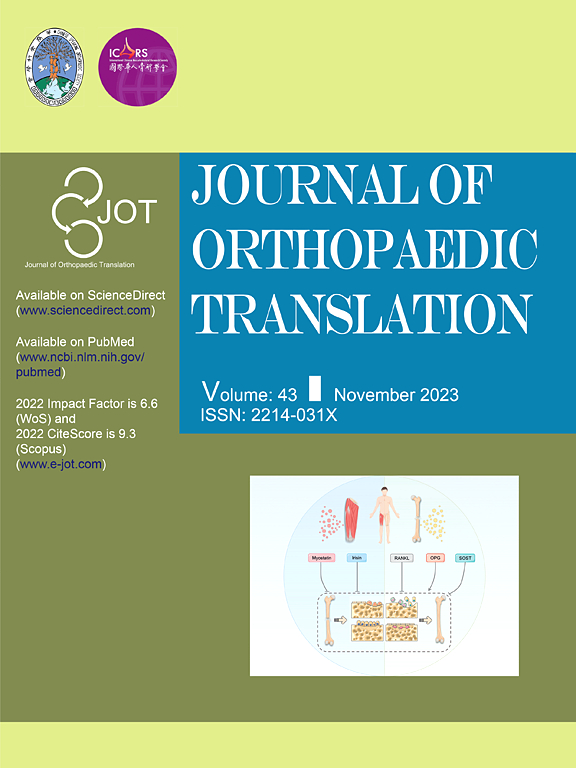n6 -甲基腺苷与椎间盘退变:检测进展和病理见解
IF 5.9
1区 医学
Q1 ORTHOPEDICS
引用次数: 0
摘要
椎间盘(IVD)退变(IDD)是一种以椎间盘恶化为特征的进行性疾病,椎间盘在脊柱中充当椎体之间的缓冲。这种退化通常与衰老有关,并可能受到各种因素的影响,包括遗传、机械压力和生活方式的选择。n6 -甲基腺苷(m6A)修饰已成为影响多种生物过程的关键转录后调控机制,包括细胞分化、增殖和应激反应。最近的研究表明m6A的修饰在IDD的病理生理中起着重要的作用。m6A甲基化的失调与参与炎症、氧化应激、细胞外基质重塑、包括凋亡、自噬、焦亡和铁亡在内的细胞死亡调控的基因表达改变有关,所有这些都有助于IDD。本文就m6A的最新检测技术及m6A在IDD病理过程中的作用进行综述,以期为IDD的分子机制提供新的认识,并寻找新的干预治疗靶点。这项工作强调了靶向m6A机制在IDD中的诊断和治疗潜力。在临床上,m6A调节因子可作为早期IDD检测或进展监测的生物标志物。在治疗上,m6A写入/删除的小分子调节剂或基于rna的策略可以恢复ECM稳态,减轻炎症,防止IVD细胞死亡。此外,先进的m6A图谱技术可以通过解码患者特异性表转录组谱来实现个性化干预。这些见解将分子机制与临床创新联系起来,为IDD治疗和再生疗法提供了新的途径。本文章由计算机程序翻译,如有差异,请以英文原文为准。

N6-methyladenosine and intervertebral disc degeneration: Advances in detection and pathological insights
Intervertebral disc (IVD) degeneration (IDD) is a progressive condition characterized by the deterioration of the intervertebral discs, which serve as cushions between the vertebrae in the spinal column. This degeneration is often associated with aging and can be influenced by various factors, including genetics, mechanical stress, and lifestyle choices. N6-methyladenosine (m6A) modification has emerged as a critical post-transcriptional regulatory mechanism that influences various biological processes, including cellular differentiation, proliferation, and response to stress. Recent studies suggest that m6A modification play significant roles in the pathophysiology of IDD. The dysregulation of m6A methylation is linked to the altered expression of genes involved in inflammation, oxidative stress, extracellular matrix remodeling, regulated cell death including apoptosis, autophagy, pyroptosis and ferroptosis, all of which contribute to the IDD. In this review, we summarize the advanced detection technology of m6A and the roles of m6A in pathological process of IDD, to provide new insights into the molecular mechanisms underlying IDD and identify novel therapeutic targets for intervention.
The translational potential of this article
This work underscores the diagnostic and therapeutic potential of targeting m6A mechanism in IDD. Clinically, m6A regulators may serve as biomarkers for early IDD detection or progression monitoring. Therapeutically, small-molecule modulators of m6A writers/erasers or RNA-based strategies could restore ECM homeostasis, mitigate inflammation, and prevent IVD cell death. Furthermore, advanced m6A mapping technologies may enable personalized interventions by decoding patient-specific epitranscriptomic profiles. These insights bridge molecular mechanisms to clinical innovation, offering novel avenues for IDD treatment and regenerative therapies.
求助全文
通过发布文献求助,成功后即可免费获取论文全文。
去求助
来源期刊

Journal of Orthopaedic Translation
Medicine-Orthopedics and Sports Medicine
CiteScore
11.80
自引率
13.60%
发文量
91
审稿时长
29 days
期刊介绍:
The Journal of Orthopaedic Translation (JOT) is the official peer-reviewed, open access journal of the Chinese Speaking Orthopaedic Society (CSOS) and the International Chinese Musculoskeletal Research Society (ICMRS). It is published quarterly, in January, April, July and October, by Elsevier.
 求助内容:
求助内容: 应助结果提醒方式:
应助结果提醒方式:


